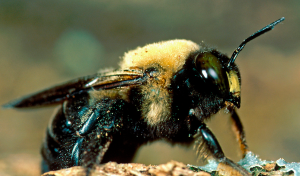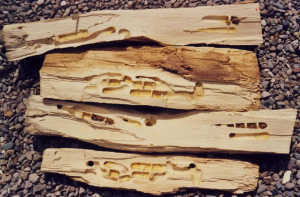Carpenter bee: Difference between revisions
No edit summary |
|||
| Line 33: | Line 33: | ||
== Life Cycle == | == Life Cycle == | ||
In April or May, the female carpenter bee searches for a good nesting site. She will reuse and expand on existing tunnels or bore her own [3]. At times, some carpenter bees will occupy the same piece of wood with nest galleries so close to each other. However, all carpenter bees behave independently of the other bees [3]. They can live up to 3 years, and there can be one or two generations per year [4]. The females do the majority of the work. They use their strong jaws (mandibles) to excavate a clean cut, which should approximately fix the diameter of her body [5]. She will eventually lay eggs once she has chewed out these tunnels. When this is done, she places a "bee bread" (a mixture of pollen and regurgitated nectar), which serves as food for the larvae [6]. Eggs will then hatch into larvae, feeding on the pollen and then eventually becoming a pupa. Later on, new adults will emerge in the late summer, chew through, and exit the tunnel. | In April or May, the female carpenter bee searches for a good nesting site. She will reuse and expand on existing tunnels or bore her own [3]. At times, some carpenter bees will occupy the same piece of wood with nest galleries so close to each other. However, all carpenter bees behave independently of the other bees [3]. They can live up to 3 years, and there can be one or two generations per year [4]. The females do the majority of the work. They use their strong jaws (mandibles) to excavate a clean cut, which should approximately fix the diameter of her body [5]. She will eventually lay eggs once she has chewed out these tunnels. When this is done, she places a "bee bread" (a mixture of pollen and regurgitated nectar), which serves as food for the larvae [6]. Eggs will then hatch into larvae, feeding on the pollen and then eventually becoming a pupa. Later on, new adults will emerge in the late summer, chew through, and exit the tunnel. | ||
[[File:Carpenter Bee Tunnel.png|400px|thumb|left|Carpenter bee's tunnel]] | [[File:Carpenter Bee Tunnel.png|400px|thumb|left|Carpenter bee's tunnel [4]]] | ||
== Ecological Significance == | == Ecological Significance == | ||
Revision as of 10:57, 30 April 2025
If you ever wonder if there were bees near wood structures around your home, chances are those are carpenter bees. They are large, solitary bees belonging to the genus Xylocopa. They get their name from the female bee because they bore into wood to create tunnels when they lay their eggs [1]. Most of the members of this group place their nest in dead solid plant material, various kinds of wood, but some use the hollow culms of bamboo or even the pithy stems of Aloe [2].

| |
| Kingdom: | Animalia |
|---|---|
| Phylum: | Arthropoda |
| Class: | Insecta |
| Order: | Hymenoptera |
| Family: | Apidae |
| Genus: | Xylocopa |
Identification
They can range from 0.7 to 1 inches long. The thorax is covered with fuzzy yellow, orange, or white hairs. The abdomen is shiny black, The female has an entirely black head while the male has yellow or white markings. They closely resemble bumble bees; unlike carpenter bees, bumble bees' entire body is covered with hairs, and they are also social, living together in an underground nest [3]. Male carpenter bees do not have a stinger, but female carpenter bees can sting when they feel threatened [1].
Life Cycle
In April or May, the female carpenter bee searches for a good nesting site. She will reuse and expand on existing tunnels or bore her own [3]. At times, some carpenter bees will occupy the same piece of wood with nest galleries so close to each other. However, all carpenter bees behave independently of the other bees [3]. They can live up to 3 years, and there can be one or two generations per year [4]. The females do the majority of the work. They use their strong jaws (mandibles) to excavate a clean cut, which should approximately fix the diameter of her body [5]. She will eventually lay eggs once she has chewed out these tunnels. When this is done, she places a "bee bread" (a mixture of pollen and regurgitated nectar), which serves as food for the larvae [6]. Eggs will then hatch into larvae, feeding on the pollen and then eventually becoming a pupa. Later on, new adults will emerge in the late summer, chew through, and exit the tunnel.

Ecological Significance
Females are attracted to raw, unfinished, or stained wood when they are searching for a nesting site. Carpenter bees cause sawdust piles below a perfectly circular hole drilled into the wood around your home. While it may sound like they aren't causing much damage, multiple tunnels, which are caused by the females, can weaken the wood over time [3].
1. Moisture entering the woods is accelerating the rate of decay
2. Mold growth on the excrement
3. Woodpeckers cause damage due to feeding on immature bees
Natural Predators
Woodpeckers can locate their favorite treat by simply keeping a sharp ear to the wind. This is due to carpenter bee larvae because they are noisy and tend to attract woodpeckers [7].
References
[1] By Native Pest Management. (2024, March 8). Do carpenter bees sting? Native Pest Management. https://www.nativepestmanagement.com/blog/2024/february/do-carpenter-bees-sting-/
[2] Minckley, R. L. (1998). A cladistic analysis and classification of the subgenera and genera of the large carpenter bees, tribe Xylocopini (Hymenoptera: Apidae) / by Robert L. Minckley. In Scientific papers - University of Kansas. Natural History Museum. https://doi.org/10.5962/bhl.title.16168
[3] Carpenter bees. (n.d.-a). University of Maryland Extension. https://extension.umd.edu/resource/carpenter-bees/
[4] Carpenter bees. (n.d.-d). https://www.fs.usda.gov/wildflowers/pollinators/pollinator-of-the-month/carpenter_bees.shtml
[5] Carpenter bees. (n.d.-c). Ohioline. https://ohioline.osu.edu/factsheet/hyg-2074
[6] Carpenter bees. (n.d.-b). https://extension.psu.edu/carpenter-bees
[7] Herwig, C. (2021, August 26). Natural enemies of carpenter bees. Best Bee Brothers, LLC. https://bestbeebrothers.com/blogs/blog/carpenter-bee-predators?srsltid=AfmBOoq1aJiJo8idYQEjcReuBIsaROrnWRj7bo8diqiUuvknLtHosMzB